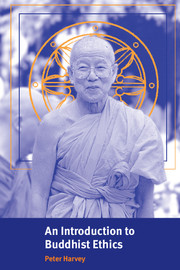Book contents
- Frontmatter
- Contents
- List of plates
- Acknowledgements
- List of abbreviations
- A note on language and pronunciation
- Introduction
- 11 THE SHARED FOUNDATIONS OF BUDDHIST ETHICS
- 12 KEY BUDDHIST VALUES
- 13 MAHĀYĀNA EMPHASES AND ADAPTATIONS
- 14 ATTITUDE TO AND TREATMENT OF THE NATURAL WORLD
- 15 ECONOMIC ETHICS
- 16 WAR AND PEACE
- 17 SUICIDE AND EUTHANASIA
- 18 ABORTION AND CONTRACEPTION
- 19 SEXUAL EQUALITY
- 10 HOMOSEXUALITY AND OTHER FORMS OF ‘QUEERNESS’
- Glossary and details of historical figures and texts
- List of references
- Useful addresses
- Index of Buddhist texts, schools cultural areas, movements and organizations
- Index of concepts
- Index of names
10 - HOMOSEXUALITY AND OTHER FORMS OF ‘QUEERNESS’
Published online by Cambridge University Press: 05 June 2012
- Frontmatter
- Contents
- List of plates
- Acknowledgements
- List of abbreviations
- A note on language and pronunciation
- Introduction
- 11 THE SHARED FOUNDATIONS OF BUDDHIST ETHICS
- 12 KEY BUDDHIST VALUES
- 13 MAHĀYĀNA EMPHASES AND ADAPTATIONS
- 14 ATTITUDE TO AND TREATMENT OF THE NATURAL WORLD
- 15 ECONOMIC ETHICS
- 16 WAR AND PEACE
- 17 SUICIDE AND EUTHANASIA
- 18 ABORTION AND CONTRACEPTION
- 19 SEXUAL EQUALITY
- 10 HOMOSEXUALITY AND OTHER FORMS OF ‘QUEERNESS’
- Glossary and details of historical figures and texts
- List of references
- Useful addresses
- Index of Buddhist texts, schools cultural areas, movements and organizations
- Index of concepts
- Index of names
Summary
His Holiness opposes violence and discrimination based on sexual orientation.
On the Dalai Lama in San Francisco, 1997The word ‘homosexuality’ derives from the Greek homos, ‘same’, rather than the Latin homo, ‘man’, so it refers to sex between either men or women. Nevertheless, ‘lesbianism’ is usually used to refer to sexual relations between females (Herdt, 1987: 445). Same-sex relationships span a spectrum from brotherly or filial affection, which is universally admired, to affectionate respect for a spiritual teacher, or strong bonds of friendship, likewise generally admired, to erotic feelings for those of the same sex, to sexual activity with those of the same sex, to a person's conscious self-identification as ‘homosexual’, ‘gay’ or ‘lesbian’. In modern Western culture, any man who engages, or has engaged, in homosexual activity has tended to be identified as ‘a homosexual’, though this way of identifying a person based on his or her sexual orientation is not found in other cultures. Gilbert Herdt identifies three forms of the cultural structuring of what is now seen as ‘homosexual’ activity (usually of males) across different cultures:
(1) age-structured homosexuality, in which people of the same sex but of different ages are sexually involved; (2) gender-reversed homosexuality, wherein a person adopts the dress, mannerisms, and sexual activities of the opposite sex; and (3) role-specialized homosexuality, in which a person, by virtue of his or her social and religious role, is entitled to engage in homosexual activity. […]
Information
- Type
- Chapter
- Information
- An Introduction to Buddhist EthicsFoundations, Values and Issues, pp. 411 - 434Publisher: Cambridge University PressPrint publication year: 2000
